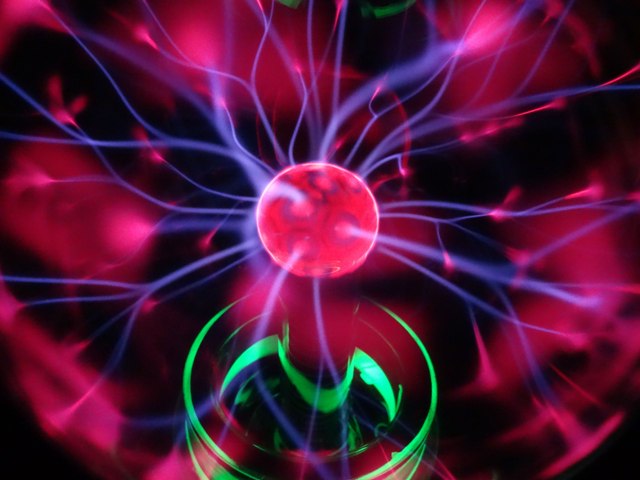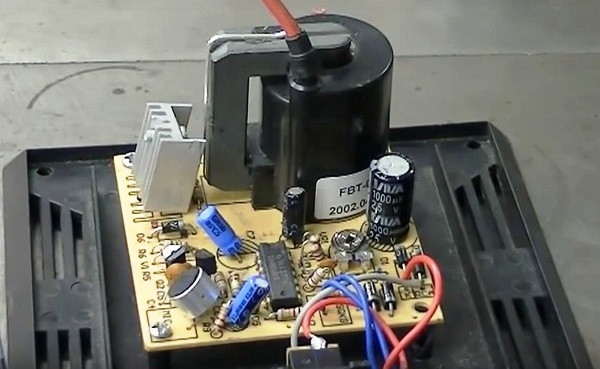Categories: How does it work
Number of views: 5541
Comments on the article: 0
Plasma lamps - how they are arranged and work
An amazing sight is a plasma lamp. A sealed glass bulb with a single high-voltage electrode installed inside, surrounded by an inert gas under almost atmospheric pressure.
High voltage (from 2000 to 5000 V) is supplied to the lamp electrode from one of the terminals of the secondary winding of a pulse transformer operating at a frequency of 30-40 kHz, which is installed inside the plastic lamp housing. A plasma lamp transformer is similar to a line transformer, which can be found on an old monitor or cathode-ray tube television.
High voltage ionizes the gas molecules (usually neon) inside the bulb - it turns out the plasma, hence the name of the lamp - "plasma lamp". Multiple discharges, similar to small lightnings, are generated by moving gas ions.
The color of these lightnings dancing around the electrode inside the bulb can be different, which depends on the type of gases that make up the mixture with which the bulb is filled. As for the length of the lightning, it depends on the potential at the electrode and on the degree of discharge of the gas filling the flask.

As you can see, there is no incandescent filament, so the service life of such devices is limited only by the quality of the electronics installed in the base of the lamp, as well as the accuracy of its owner.
The consumption of decorative plasma lamps depends on the size of the bulb and usually does not exceed 20 watts. The most common spherical and conical plasma lamps on the market today have dimensions of no more than 30 cm.
There are plasma lamps with knobs for adjusting the power supplied to the "dancing lightning": at the lowest power, only one thin luminous thread is formed inside the lamp.
If the power is gradually increased, the thread will become brighter and brighter, finally, when one thread is overflowed with the energy supplied through it, the second thread will appear at that moment, and they will begin to repel each other like the same charges.
The luminous filaments are thin, since the magnetic fields surrounding them have a magnetohydrodynamic effect such as self-focusing: the intrinsic magnetic field of the plasma channel creates a force acting on its compression.
The inventor of the first prototype of the device, which we today call a plasma lamp, was a scientist Nikola Tesla (1856-1943), American electrical engineer, a native of the Austrian Empire.
In US patent No. 514170 of 1894, the lamp, although it is called an "electric light source", is nevertheless a fundamental difference from a conventional incandescent lamp. Tesla proposed a fundamentally new lamp - a lamp with one electrode, which would be powered from Tesla high voltage resonant transformer.
The popularizer of the idea of a plasma lamp as a decorative lamp in the shape of a ball (the commercial idea of a "plasma globe") was in the 1970s, the inventor from Pennsylvania, James Falk (born 1954).
In his time, unlike the times when Tesla worked on his lamp, the technology of creating gas mixtures of various compositions (based on xenon, neon and krypton) has already appeared, allowing to obtain plasma of various colors in flasks.
The glow here is created due to the corona discharge in the gas, practically caused by the current through the capacitance in the lamp-air-ground circuit. As the ground for the high-voltage source of the lamp, a zero potential point is used, which is available when the device is powered from the outlet.

It is believed that when a person touches the glass of a working lamp with his finger, the energy flow goes through the body, as if it had a resistance of 1000 Ohms and was connected in series with a capacitor of 150 pF (the glass of the bulb acts as a dielectric).It does not kill a person, since the current of a plasma lamp is quite high-frequency.
One way or another, in contact with the plasma lamp, observe safety measures. The fact is that an alternating electric field acts not only in the wires of a high-voltage lamp source, but also outside the bulb.
A metal object located near the lamp will become electrified by an alternating electric field, and touching such an object can cause a slight electric shock and even a burn. If a person, touching the lamp, accidentally turns out to be grounded, for example, holding on to the battery, he will receive an electric shock.
In addition, no electronic devices should be placed near a working plasma lamp, because any electronics is afraid of induced electric currents, and will easily fail if it gets into an alternating electric field of high tension, the source of which is the electrode inside the lamp.
See also at bgv.electricianexp.com
:
